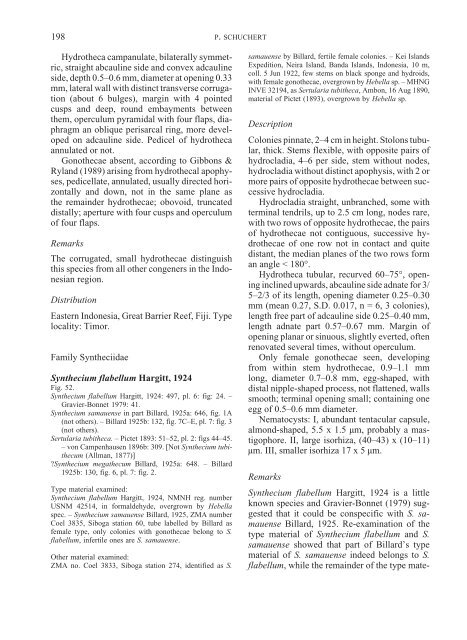Hydroids (Cnidaria, Hydrozoa) of the Danish expedition to
Hydroids (Cnidaria, Hydrozoa) of the Danish expedition to
Hydroids (Cnidaria, Hydrozoa) of the Danish expedition to
You also want an ePaper? Increase the reach of your titles
YUMPU automatically turns print PDFs into web optimized ePapers that Google loves.
198<br />
Hydro<strong>the</strong>ca campanulate, bilaterally symmetric,<br />
straight abcauline side and convex adcauline<br />
side, depth 0.5–0.6 mm, diameter at opening 0.33<br />
mm, lateral wall with distinct transverse corrugation<br />
(about 6 bulges), margin with 4 pointed<br />
cusps and deep, round embayments between<br />
<strong>the</strong>m, operculum pyramidal with four flaps, diaphragm<br />
an oblique perisarcal ring, more developed<br />
on adcauline side. Pedicel <strong>of</strong> hydro<strong>the</strong>ca<br />
annulated or not.<br />
Gono<strong>the</strong>cae absent, according <strong>to</strong> Gibbons &<br />
Ryland (1989) arising from hydro<strong>the</strong>cal apophyses,<br />
pedicellate, annulated, usually directed horizontally<br />
and down, not in <strong>the</strong> same plane as<br />
<strong>the</strong> remainder hydro<strong>the</strong>cae; obovoid, truncated<br />
distally; aperture with four cusps and operculum<br />
<strong>of</strong> four flaps.<br />
Remarks<br />
The corrugated, small hydro<strong>the</strong>cae distinguish<br />
this species from all o<strong>the</strong>r congeners in <strong>the</strong> Indonesian<br />
region.<br />
Distribution<br />
Eastern Indonesia, Great Barrier Reef, Fiji. Type<br />
locality: Timor.<br />
Family Syn<strong>the</strong>ciidae<br />
Syn<strong>the</strong>cium flabellum Hargitt, 1924<br />
Fig. 52.<br />
Syn<strong>the</strong>cium flabellum Hargitt, 1924: 497, pl. 6: fig: 24. –<br />
Gravier-Bonnet 1979: 41.<br />
Syn<strong>the</strong>cium samauense in part Billard, 1925a: 646, fig. 1A<br />
(not o<strong>the</strong>rs). – Billard 1925b: 132, fig. 7C–E, pl. 7: fig. 3<br />
(not o<strong>the</strong>rs).<br />
Sertularia tubi<strong>the</strong>ca. – Pictet 1893: 51–52, pl. 2: figs 44–45.<br />
– von Campenhausen 1896b: 309. [Not Syn<strong>the</strong>cium tubi<strong>the</strong>cum<br />
(Allman, 1877)]<br />
?Syn<strong>the</strong>cium mega<strong>the</strong>cum Billard, 1925a: 648. – Billard<br />
1925b: 130, fig. 6, pl. 7: fig. 2.<br />
Type material examined:<br />
Syn<strong>the</strong>cium flabellum Hargitt, 1924, NMNH reg. number<br />
USNM 42514, in formaldehyde, overgrown by Hebella<br />
spec. – Syn<strong>the</strong>cium samauense Billard, 1925, ZMA number<br />
Coel 3835, Siboga station 60, tube labelled by Billard as<br />
female type, only colonies with gono<strong>the</strong>cae belong <strong>to</strong> S.<br />
flabellum, infertile ones are S. samauense.<br />
O<strong>the</strong>r material examined:<br />
ZMA no. Coel 3833, Siboga station 274, identified as S.<br />
P. SCHUCHERT<br />
samauense by Billard, fertile female colonies. – Kei Islands<br />
Expedition, Neira Island, Banda Islands, Indonesia, 10 m,<br />
coll. 5 Jun 1922, few stems on black sponge and hydroids,<br />
with female gono<strong>the</strong>cae, overgrown by Hebella sp. – MHNG<br />
INVE 32194, as Sertularia tubi<strong>the</strong>ca, Ambon, 16 Aug 1890,<br />
material <strong>of</strong> Pictet (1893), overgrown by Hebella sp.<br />
Description<br />
Colonies pinnate, 2–4 cm in height. S<strong>to</strong>lons tubular,<br />
thick. Stems flexible, with opposite pairs <strong>of</strong><br />
hydrocladia, 4–6 per side, stem without nodes,<br />
hydrocladia without distinct apophysis, with 2 or<br />
more pairs <strong>of</strong> opposite hydro<strong>the</strong>cae between successive<br />
hydrocladia.<br />
Hydrocladia straight, unbranched, some with<br />
terminal tendrils, up <strong>to</strong> 2.5 cm long, nodes rare,<br />
with two rows <strong>of</strong> opposite hydro<strong>the</strong>cae, <strong>the</strong> pairs<br />
<strong>of</strong> hydro<strong>the</strong>cae not contiguous, successive hydro<strong>the</strong>cae<br />
<strong>of</strong> one row not in contact and quite<br />
distant, <strong>the</strong> median planes <strong>of</strong> <strong>the</strong> two rows form<br />
an angle < 180°.<br />
Hydro<strong>the</strong>ca tubular, recurved 60–75°, opening<br />
inclined upwards, abcauline side adnate for 3/<br />
5–2/3 <strong>of</strong> its length, opening diameter 0.25–0.30<br />
mm (mean 0.27, S.D. 0.017, n = 6, 3 colonies),<br />
length free part <strong>of</strong> adcauline side 0.25–0.40 mm,<br />
length adnate part 0.57–0.67 mm. Margin <strong>of</strong><br />
opening planar or sinuous, slightly everted, <strong>of</strong>ten<br />
renovated several times, without operculum.<br />
Only female gono<strong>the</strong>cae seen, developing<br />
from within stem hydro<strong>the</strong>cae, 0.9–1.1 mm<br />
long, diameter 0.7–0.8 mm, egg-shaped, with<br />
distal nipple-shaped process, not flattened, walls<br />
smooth; terminal opening small; containing one<br />
egg <strong>of</strong> 0.5–0.6 mm diameter.<br />
Nema<strong>to</strong>cysts: I, abundant tentacular capsule,<br />
almond-shaped, 5.5 x 1.5 µm, probably a mastigophore.<br />
II, large isorhiza, (40–43) x (10–11)<br />
µm. III, smaller isorhiza 17 x 5 µm.<br />
Remarks<br />
Syn<strong>the</strong>cium flabellum Hargitt, 1924 is a little<br />
known species and Gravier-Bonnet (1979) suggested<br />
that it could be conspecific with S. samauense<br />
Billard, 1925. Re-examination <strong>of</strong> <strong>the</strong><br />
type material <strong>of</strong> Syn<strong>the</strong>cium flabellum and S.<br />
samauense showed that part <strong>of</strong> Billard’s type<br />
material <strong>of</strong> S. samauense indeed belongs <strong>to</strong> S.<br />
flabellum, while <strong>the</strong> remainder <strong>of</strong> <strong>the</strong> type mate-

















